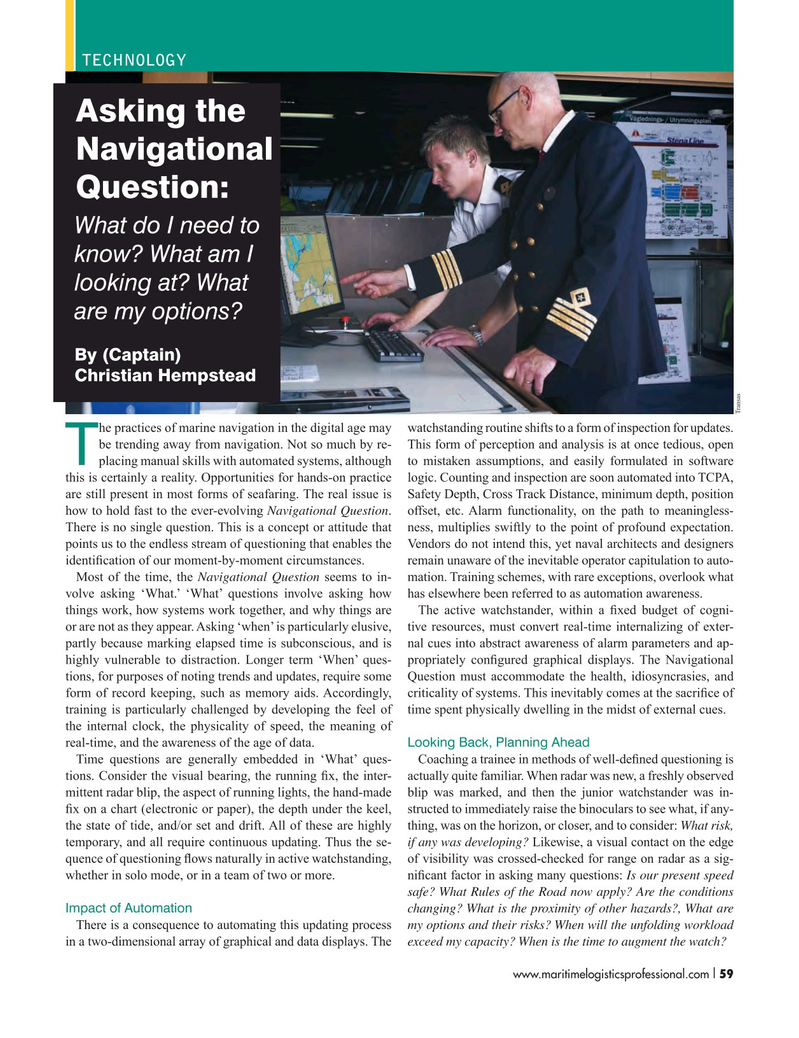
Page 59: of Maritime Logistics Professional Magazine (Q3 2016)
Shipbuilding, Repair & Maintenance
Read this page in Pdf, Flash or Html5 edition of Q3 2016 Maritime Logistics Professional Magazine
TECHNOLOGY
Asking the
Navigational
Question:
What do I need to know? What am I looking at? What are my options?
By (Captain)
Christian Hempstead
Transas he practices of marine navigation in the digital age may watchstanding routine shifts to a form of inspection for updates. be trending away from navigation. Not so much by re- This form of perception and analysis is at once tedious, open
Tplacing manual skills with automated systems, although to mistaken assumptions, and easily formulated in software this is certainly a reality. Opportunities for hands-on practice logic. Counting and inspection are soon automated into TCPA, are still present in most forms of seafaring. The real issue is Safety Depth, Cross Track Distance, minimum depth, position how to hold fast to the ever-evolving Navigational Question. offset, etc. Alarm functionality, on the path to meaningless-
There is no single question. This is a concept or attitude that ness, multiplies swiftly to the point of profound expectation. points us to the endless stream of questioning that enables the Vendors do not intend this, yet naval architects and designers identi? cation of our moment-by-moment circumstances. remain unaware of the inevitable operator capitulation to auto-
Most of the time, the Navigational Question seems to in- mation. Training schemes, with rare exceptions, overlook what volve asking ‘What.’ ‘What’ questions involve asking how has elsewhere been referred to as automation awareness.
things work, how systems work together, and why things are The active watchstander, within a ? xed budget of cogni- or are not as they appear. Asking ‘when’ is particularly elusive, tive resources, must convert real-time internalizing of exter- partly because marking elapsed time is subconscious, and is nal cues into abstract awareness of alarm parameters and ap- highly vulnerable to distraction. Longer term ‘When’ ques- propriately con? gured graphical displays. The Navigational tions, for purposes of noting trends and updates, require some Question must accommodate the health, idiosyncrasies, and form of record keeping, such as memory aids. Accordingly, criticality of systems. This inevitably comes at the sacri? ce of training is particularly challenged by developing the feel of time spent physically dwelling in the midst of external cues. the internal clock, the physicality of speed, the meaning of real-time, and the awareness of the age of data. Looking Back, Planning Ahead
Time questions are generally embedded in ‘What’ ques- Coaching a trainee in methods of well-de? ned questioning is tions. Consider the visual bearing, the running ? x, the inter- actually quite familiar. When radar was new, a freshly observed mittent radar blip, the aspect of running lights, the hand-made blip was marked, and then the junior watchstander was in- ? x on a chart (electronic or paper), the depth under the keel, structed to immediately raise the binoculars to see what, if any- the state of tide, and/or set and drift. All of these are highly thing, was on the horizon, or closer, and to consider: What risk, temporary, and all require continuous updating. Thus the se- if any was developing? Likewise, a visual contact on the edge quence of questioning ? ows naturally in active watchstanding, of visibility was crossed-checked for range on radar as a sig- whether in solo mode, or in a team of two or more. ni? cant factor in asking many questions: Is our present speed safe? What Rules of the Road now apply? Are the conditions
Impact of Automation changing? What is the proximity of other hazards?, What are
There is a consequence to automating this updating process my options and their risks? When will the unfolding workload in a two-dimensional array of graphical and data displays. The exceed my capacity? When is the time to augment the watch?
www.maritimelogisticsprofessional.com 59I 50-63 Q3 MP2016.indd 59 8/17/2016 10:29:17 AM

 58
58

 60
60
